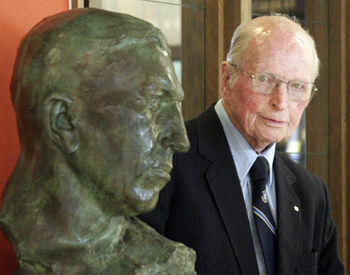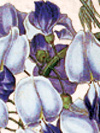| History of the Memorial Room Collection Page 1 |
|
|||||||||||||||||
 |
Expanded remarks by Professor Emeritus, Wm. C. Gibson, D.Phil.(Oxon) M.D., F.R.C.P., September 7, 1988 at the dedication of the Historical Collection of the Woodward Library, University of British Columbia. The Life Sciences Libraries thanks Dr. William Gibson for his kind permission to reproduce his historical comments on the Historical Collection of the Woodward Library. |
||||||||||||||||
My interest in the history of medicine and science began on a farm in the mountains of Idaho where, in the summer of 1933, soon after graduating from U.B.C., I was charged with the running of a large and mixed farm of my medical uncle, Dr. Charles Franklin Magee, a McGill graduate in medicine, who practiced in the University town of Moscow. As a result I arrived in Montreal in the autumn of 1933 keen to see the fabled Osler Library of 7,600 rare volumes built up by Sir William over his seventy eventful years, and bequeathed to McGill on his death at Oxford at age 70 in 1919. His nephew Dr. William Willoughby Francis was the Osler Librarian and gave humourous rather than ponderous tours of the very beautiful room and its contents. It was not long before I met Osler's devoted pupil Dr. Maude Abbott whose work at McGill had made her the world's authority on congenital heart disease, and formed the basis for the eventual surgery of the heart. Maude was almost cubical in dimension with a wonderful personality. Francis on learning that Maude had been trapped between two trams on St. Catherine Street going in opposite directions and had been spun like a top between the cars, put out word that this was proof that "Maudie" was made of rubber, not blubber. He had a sharp but benign wit. When I went off to Oxford in 1935 following a year with Dr. Wilder Penfield as a graduate research student, Dr. Francis provided many helpful introductions to the scholars who worked with him at Oxford in cataloguing the Osler collection. At that time it was said to be the greatest literary treasure ever to cross the Atlantic. I was "the last pupil" of Sir Charles Sherrington, O.M., P.R.S., the boon companion of U.B.C.'s President Wesbrook when the two studied together at Cambridge from 1892-1895. At Oxford, Sir Charles had built up, since 1913 when he became Waynflete Professor of Physiology, one of the world's most prestigious research and teaching laboratories. Not only did he win the Nobel Prize in medicine and physiology, three of his Oxford students did also - Eccles, Florey and Granit. Sherrington told me that "the last illegal thing" he had done was to appoint me to a demonstratorship in his department from which he had just retired. He was a font of information on the early history of all physiology and especially neurophysiology. He opened many doors for me and introduced me to scholars in the history of medicine. I had already met his pupils Harvey Cushing and John Fulton at Yale University, on a month-long safari from McGill. Over tea at the Royal Society in London, or in the library of the Royal College of Surgeons, at Lincoln's Inn Fields, he was a never-ending encyclopedia of historical data. When I returned to British Columbia in 1938 Sherrington sent with me his own copy of Laurentius Valla's Elegant Latin Language printed in 1476, and still in excellent condition. It was to go into the U.B.C. Library as memorial to "dear Frank Wesbrook" as C.S.S. always referred of him. It is probably the oldest volume at U.B.C. Sherrington had already sent to U.B.C. in 1915 the great copper plate volume of Bidloo's Anatomy printed in 1685 in Holland. It was later plagiarized by William Cowper, the British surgeon, who had to pay Bidloo one shilling's damages in a London court for his poaching. The copy sent by Sherrington had been purchased in 1693 by Nicholas Hawksmoor, the pupil of Sir Christopher Wren, and architect of several Oxford colleges. Sherrington had acquired it when he was a student at Cambridge in 1887. Before the great volume left Oxford, Sir Charles had some friends who visited his laboratory sign their names on the end papers. They included Wesbrook's friend Sir William Osler, as well as John McCrae, the soldier poet and pathologist who wrote In Flanders Fields, and Sir Frederick Gowland Hopkins of vitamin discovery fame. Actually, the first volume in the field of medical history was sent to U.B.C. by Sir William Osler early on. It contained facsimiles of William Harvey's anatomical lectures read before the Royal College of Physicians of London in 1616, in which he adumbrated his discovery that the blood moves in a circle. |
|||||||||||||||
|
|||||||||||||||

 He left me the two-volume Life of Sir William Osler by Harvey Cushing to read by kerosene lamp after the day's work was done. After the animals had been put down for the night I made my supper and settled down to this fine piece of prose about a remarkable Canadian physician and author who had taught consecutively at McGill, Pennsylvania, Johns Hopkins and Oxford.
He left me the two-volume Life of Sir William Osler by Harvey Cushing to read by kerosene lamp after the day's work was done. After the animals had been put down for the night I made my supper and settled down to this fine piece of prose about a remarkable Canadian physician and author who had taught consecutively at McGill, Pennsylvania, Johns Hopkins and Oxford. 

